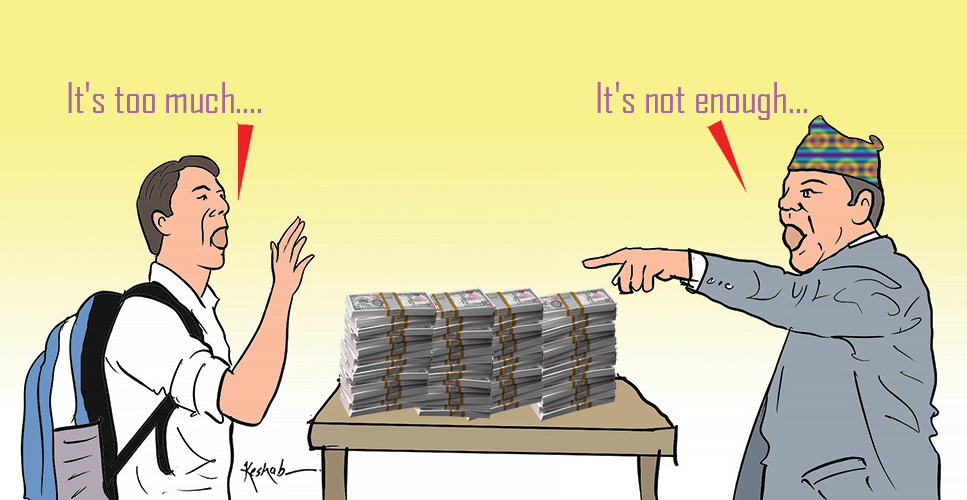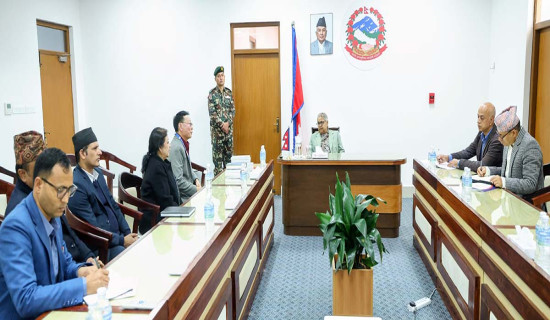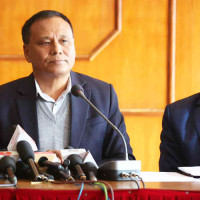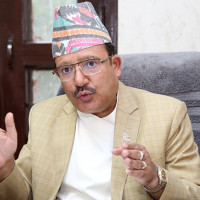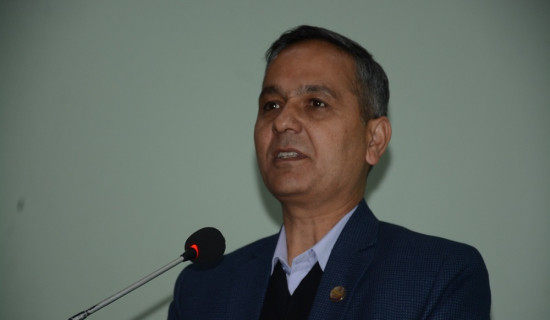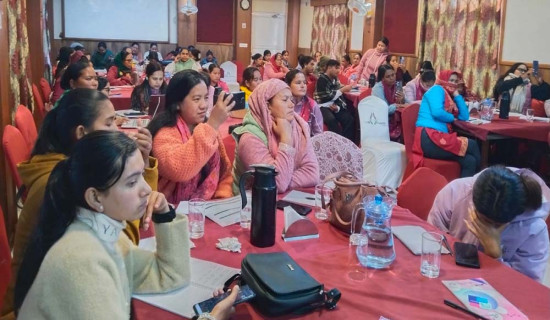- Wednesday, 24 December 2025
Medical colleges continue charging excess fees
By Nayak Paudel Kathmandu, May 1: The 2015 batch MBBS students of Pokhara-based Gandaki Medical College (GMC) protested for five days until April 24. The students, who are deployed as interns by the college, had asked the college to pay for their internships.
However, the protest was postponed on April 24 after the agitating students had to prepare for their exams. According to the students, the college has been paying Rs. 12,500 for interns as stipend. However, they haven’t been paid for the past five months.
GMC, a private-medical college affiliated with Tribhuvan University, has been mired in conflict with medical students for a long time now.
In 2019, the students had also protested against the GMC for demanding fees in excess of government ceiling. The strike, which closed the college’s hospital for 30 days, lasted 54 days.
The agitating students, through their Facebook page ‘GMC Solidarity for Justice’, have also stated that the college was still demanding extra fees despite having already paid the government-set amount.
They also accused the college of blocking their internship stipend for not paying the ‘extra’.
Meanwhile, resident doctors pursuing MD/MS/MDS in private medical colleges have also approached authorities over payment of insufficient stipend and ordeals of working from 48 to 72 hours straight (even up to 128-140 hours a week).
A memorandum was submitted by the resident doctors to Dr. Shrikrishna Giri, vice-chairperson of Medical
Education Commission (MEC), on April 20, demanding fair stipend and just duty hours.
The students, who had reached the MEC on Wednesday, told The Rising Nepal that private medical colleges were paying them as little as Rs. 14,800 per month.
Resident doctors at Kathmandu Medical College (KMC) have also shared a photo of an agreement letter with the college administration for newly admitted postgraduate students stating that the student should accept the situation even if the college fails to pay monthly stipend.
From admission fee to the stipend payment to interns and resident doctors, private medical colleges and students have always been in dispute with each other.
Students demand the reduction in fee. The colleges, however, maintain that they cannot survive on the government-set fee structure.
How much is the fee?
The fee for MBBS course has been set at Rs. 4,023,250 for colleges within the Valley and Rs. 4,436,025 for those outside by the MEC in May, 2021.
The earlier fee ceiling was Rs. 3.8 million and Rs. 4.24 million for the colleges inside and outside the Valley respectively.
The fee of MD/MS/MDS (Clinical) has been set at Rs. 2,299,000 and MD/MS/MDS (Basic science) at Rs. 1,048,135.
MBBS students have protested in recent years saying that they have been asked as much as Rs. six million in all from one student.
In the case of postgraduate course, the Tribhuvan University (TU) Executive Council on March 26, 2018, had reduced the total fee for the degree to Rs. 2.2 million from Rs. 3.1 million.
How is the fee set?
The commission’s formation introduced a regulatory body of overall medical education across the country.
It came into effect in 2020 under the National Medical Education Act, 2019.
It has since maintained a uniform fee structure, regulated misdeeds and started conducting common medical entrance examination, among others.
Section 18 (1) of the Act states that the fee for undergraduate medical courses will be set by the MEC on the basis of investment, operating cost, inflation, geography and scholarship rate of universities, academies and medical colleges.
It is uniform for private and government institutions.Meanwhile, Sub-section 2(A) of Section 18 states that the fee for postgraduate courses in institutions other than the government’s will be decided by the MEC on the basis of recommendations from respective university, academy and institution.
Sub-section 2(B) provisions that Nepali students will not be charged for postgraduate courses in government colleges and the college will pay adequate stipend to the students.
There is no such provision for private medical colleges.
What private medical college owners say?
In a meeting with the Parliament’s Education and Health Sub-Committee on June 5, 2019, private medical colleges had admitted charging extra fees from the students citing that the government’s fee structure was insufficient to run the colleges.
The dissatisfaction persists because their recommendations continue to fall on deaf ears.
The Department of Health Services (DoHS) website shows that there are 19 medical colleges in Nepal, of which only five are operated by the government.
“Private medical colleges have poured billions in investment taking loans to provide quality medical services outside the Valley,” said Khuma Prasad Aryal, chairman at the GMC, adding, “This is why the public and authorities should not compare private medical colleges with the government ones.”
According to Aryal, the government should be able to provide equal support to both public and private institutions.
“We have to manage infrastructure, salaries, faculty costs and operating costs, among others, ourselves. In government medical colleges, government covers those costs. We provide 10 per cent scholarship to MBBS students under our own expenses. A tax of 25 per cent is paid to the government. And we receive nothing in return but are expected to provide everything,” Aryal told The Rising Nepal.
The government medical colleges provide scholarship to 75 per cent of the total students while private ones provide 10 per cent.
“If the government cannot provide similar support to us as it has been doing to the state-run institutions, it would be better if they set a different fee structure for private colleges based on proper scientific analysis of our investment and operating cost,” said Aryal.
Responding to the query on whether the GMC interns would be paid or not, Aryal said, “If we haven’t paid, then it means we don’t have money.”
What do authorities say?
“A committee is formed to suggest the MEC on a new fee structure. It constitutes senior officials from government bodies including the National Planning Commission. They study the operating costs and inflation alongside discussions with concerned stakeholders. The commission later decides on the suggestion after further review,” said Semanta Raj Koirala, MEC information officer.
“Government medical colleges do get grant and budget for operation and don’t suffer financially. Private medical colleges operate on their own. The differences are vast but once a fee ceiling is set, it is necessary to follow,” said Koirala.
Talking to The Rising Nepal, Registrar at Nepal Medical Council (NMC) Dr. Krishna Prasad Adhikary said, “As the row over fees demanded by private medical colleges linger, the students continue to bear the brunt.
Medical students should be allowed to study in peace rather than fight for fair fees, payment and duty hours. We constantly lobby with other authorities about the need to find a permanent solution to the problems in medical education.”
Until December, 2021, 30,133 doctors have been registered with the NMC including 8,862 MD/MS/MDS graduates. Around 2,000 doctors are produced annually in Nepal.
What do the students say?
A newly admitted postgraduate student at Lumbini Medical College on condition of anonymity said, “The new session is starting. I am already distressed due to insufficient stipend and excess duty hours. We approached the commission requesting to end the problem. Let’s see how things pan out.”
“If we remain quiet, the college will demand more and more money from us. If we protest, the college would back off a little but we continue to suffer academically. More than Rs. 4 million is spent for the MBBS degree but it seems less for the private colleges,” said a 2016-batch MBBS student at the GMC who requested anonymity.
The student added, “College uses resident doctors and resident doctors pressure MBBS interns. Senior doctors treat patients in severe conditions only. Meanwhile, students are used as cheap labour.”
According to several private medical college students with whom The Rising Nepal talked to, it is difficult to continue studying peacefully if they protested against the colleges.
Resident doctors informed that People’s Dental College is paying Rs. 14,800 as stipend while most colleges
affiliated with Kathmandu University Rs. 19,800.
Doctors informed that Chitwan Medical College (CMC) is paying around Rs. 20,000 on average during the three-year period while KIST Medical College
Rs. 16,000. Resident doctors at the CMC informed that they have been asked to pay Rs. 10,000 as extra recently.
Meanwhile, government medical colleges were paying Rs. 42,000 to a resident doctor as stipend.
“Fee structure shouldn’t be increased, but decreased to the lowest amount possible. A proper system should be formed by the government to end disparity and conflicts in medical education. Affecting a medical student’s academic is a great loss for the country,” said Dr. Toshima Karki, a member of Nepal Medical Council. Dr. Karki had also led the resident doctors to submit their memorandum to the MEC’s vice-chair.
“We will reach ministries, human rights commission and labour/employment departments to raise the issue. Medical personnel should be treated in ways they deserve,” said Dr. Karki.
All the agitating students requested the government, universities and the MEC to be harsh against private medical colleges, saying that the lack of action despite wrongdoing after wrongdoing has enabled them to ignore the legitimate demand.

